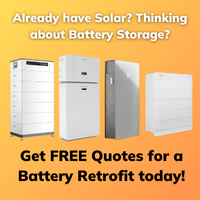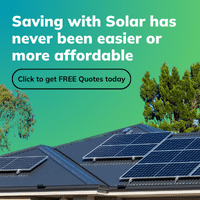Quite often we’re asked about the advantages of monocrystalline panels and polycrystalline solar modules over their amorphous thin film counterparts; particularly in home solar power grid connect systems and how they affect the life of a solar panel.
In all our grid connect packages, we only use good quality poly or monocrystalline panels (except in very specific circumstances) for the following reasons:

Less roof space required
Mono and polycrystalline modules need far less surface/roof area – and roof space is very valuable real estate when it comes to solar energy related electricity production. You may have just enough roof space to deck it out in thin film panels now; but what about later if you wish to upgrade? We’ve seen instances where home owners have had to rip up all their thin film panels and sell those at a loss in order to boost the size of their solar power system.
In the future, solar energy may also have a huge role in personal transport – such as recharging electric vehicles.
With the world rapidly moving towards renewable energy sources, we envision a time in the not-too-distant future where the type of solar array used; specifically the ability to scale up, will also factor into house price values.
Don’t underestimate the value of your north facing roof area – poly and mono solar panels are the best choice, even just on that point alone.
Ease of installation
Some amorphous thin film panels actually need more mounting rails and take longer to install; adding to the overall cost of the system
Embodied energy
While thin film offers a lower level of embedded energy per panel, the fact that more panels are needed somewhat negates this aspect, especially given the extra mounting rails sometimes needed. Embodied energy refers to the amount of energy required to manufacture and supply a product.
Other environmental concerns
Some thin film solar products uses cadmium telluride (CdTe). Cadmium is a heavy metal that accumulates in plant and animal tissues. Cadmium is a ‘probable carcinogen’ in humans and animals. While cadmium telluride doesn’t pose a threat while the panel is in service, disposal of this toxic waste when the product reaches the end of its life comes at large cost and suitable facilities are not present in Australia currently
General performance
We’ve noticed that some companies use reports and impressive graphs on efficiency to show amorphous thin film as being superior. In most cases we’ve seen, the data originates from the late 1990’s. It’s over 20 years old! Like any technology, solar power has rapidly evolved, and that includes the performance of polycrystalline and monocrystalline panels.
In most conditions in Australia, we strongly recommend poly/monocrystalline panels; the only exceptions being far North Queensland and the Northern Territory where amorphous thin film may have some performance advantages during the hottest times of the year and given the amount of solar radiation in those areas (a separate issue to heat.).
Durability: life of a solar panel cell
Thin film is still relatively new technology whereas mono and poly panels have been around for decades. Some monocrystalline panel installations in the 1970’s are still cranking out power today. Monocrystalline has even withstood the rigours of space travel! Amorphous thin film is yet to prove itself in harsh conditions over a long period of time. If the life of a solar panel is important to you, then this is a factor to consider.
Flate plate vs. tempered glass
In many grid connect packages where thin film is utilized, the panels have a cover of plate glass. This is incredibly inferior to tempered glass, both from a safety and durability aspect. The type of glass used in a panel is so important. It just doesn’t pay to cut costs by cutting corners on material quality. We’ve published a full article just on this topic – plate vs tempered glass.
Exaggerated claims of shading tolerance
The simple fact of the matter is, no panel is shade tolerant to any great degree and it just doesn’t make sense to install an expensive solar power system in an area that experiences a great deal of shade as the system’s performance will be extremely low.
Comparing apples to apples in grid connect
In a addition to the above points, if you’re looking to buy a solar power grid connect system, ensure you compare similar systems in terms of price – what you are getting for your money. The difference between a 1kw system and a 1.3kw system may not sound like much, but there’s a huge difference in power output; approximately 33%.
Adding to your system in the future
As mentioned, the panels we use are some of the best in the solar industry – proven, long lasting, produced in high quantities and will still available for years to come. If in the future you wish to increase your system or need to replace a panel for whatever reason, there will be no shortage in obtaining these products. Many manufacturers actually produce very similar panels in terms of dimensions. Therefore that means you are not tied to one particular manufacturer, but actually have a choice.
In the case of thin film there is no such assurance as these panels originate in much lower quantities by a smaller number of manufacturers. You might find that you are stuck with old technology that cannot have easy upgrades.
So why do we sell thin film panels?
Energy Matters does stock thin film solar panels, and all are good quality brands. As mentioned, we recommend amorphous thin film for North Queensland and for the Northern Territory. Flexible thin film panels are also extremely well suited to curved structures where flat panel mounting isn’t viable. Thin film is also desirable for some off grid and mobile applications as they are lightweight. Finally, we also sell them because our customers demand them. However, we do point out the advantages of monocrystalline when people enquire.
There’s a great deal of competition among suppliers of grid connect systems now given the generous government solar power rebates on offer and the decreasing price of solar technology. It’s very important that consumers shop around and check the marketing of systems against the actual facts behind any particular type of component before making a purchase decision. Don’t be afraid to ask questions. After all, it’s a substantial investment and a decision you’ll be living with for a very long time!
Confused about grid connect solar power? Contact one of our friendly experts for free, no-obligation advice tailored to your specific needs on 1800 EMATTERS (1800 362 883) or via email.
Related – Tips for buying solar panels











































